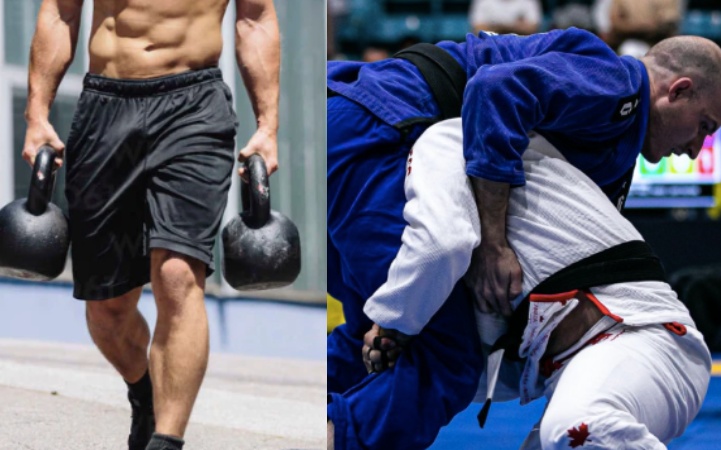Guest post by Evolve MMA, Asia’s premier championship brand for martial arts. It has the most number of World Champions on the planet. Named as the #1 ranked martial arts organization in Asia by CNN, Yahoo! Sports, FOX Sports, Evolve MMA is the top rated BJJ gym in Singapore.
The farmer’s carry is the ultimate exercise for forgotten and neglected muscles in your body. It’s one of the most basic strength and conditioning exercises, and we all do it to a point as we engage in everyday activities. Carrying a bag of groceries into your home? You’re performing a farmer’s carry, even if your form is less than perfect.
The farmer’s carry is a favorite among dedicated weightlifters and athletes interested in increasing their functional strength, and it carries over to your daily routine more than most exercises.
Build Elite Functional Strength With The Farmer’s Carry
The farmer’s carry is a basic exercise that involves holding a heavy object in each hand. You then stand up straight and walk anywhere from 20 to 100 meters while carrying the weights. Some of the muscles that are engaged during this exercise include:
To perform a conventional farmer’s carry:
- Choose a weight that is somewhere between 25 to 50 percent of your body weight in each hand.
- Maintain a tight grip on the weight and keep your arms extended by your sides.
- Push your chest out and pull your shoulders back for good posture and walk 20 to 100 meters. The weight is too much for you if you cannot get up to 20 meters. It’s too light if you can easily walk 100 meters.
Some of the benefits of adding this exercise to your workout routine include:
- Improved posture
- Improved breathing
- Stronger grip
- Increased shoulder stability
- Improved mental toughness
- Increased functional strength and endurance
Farmer’s Carry Variations
Some of the different variations of the farmer’s carry include:
1) Dumbbell Offset Carry
This version of the farmer’s carry involves holding a heavy load in the standard farmer’s carry position with your arm down by your side while carrying a lighter load overhead. This variation forces your shoulder muscles and core to do more work while you maintain a neutral spine. Walk a set distance in the offset carry position, then switch hands and walk the same distance again.
Here’s what the exercise looks like:
- Stand with your feet about hip-width apart and with a heavy dumbbell in one hand and a lighter one in the other.
- Clean the lighter dumbbell to your shoulder by hinging at your hips and extending through your hips, and shrug the dumbbell upward. Catch the dumbbell once it reaches your shoulder and press it overhead until you lock out your elbow.
- Keep your wrist aligned with your shoulder and brace your core before walking. Walk for a set distance and switch hands.
2) Suitcase Carry
The suitcase carry is a variation of the farmer’s carry that can be performed with either a dumbbell or kettlebell. The exercise targets your arms, upper back, shoulders, core, calves, hip flexors, glutes, quadriceps, and hamstrings.
The benefits of adding this exercise to your workout routine include improved trunk rotation, extension, flexion, posture, shoulder stability, and balance. It also helps to improve your grip strength and addresses imbalances on either side of your body.
The suitcase carry mimics daily activities like carrying groceries into your home or a suitcase to your car. Many people have muscle imbalances since we tend to favor one side of our bodies when performing such activities.
Here’s what a farmer’s carry looks like:
- Pick up a kettlebell or dumbbell with your non-dominant hand and stand upright with your feet placed shoulder-width apart. Your arms should be hanging by your sides.
- Tighten your core muscles and pull your shoulder blades back and down to maintain proper posture.
- Start walking forward with the kettlebell or dumbbell in your hand. Take small, slow steps and maintain proper posture while walking. Don’t cheat by using your forward momentum to make your steps easier.
- Walk a set distance or time and repeat the exercise with your other side.
3) Goblet Carry
This variation of the farmer’s carry can be performed using dumbbells or kettlebells. It forces your core, traps, and forearms to do more of the work during your carries and effectively builds functional strength in these areas.
Here’s what the exercise looks like:
- Grab a kettlebell by its horns or a dumbbell with both hands and keep it at chest level.
- Keep the weight at chest level as you walk a set distance. Maintain good posture while walking forward and take slow steps.
- Keep the weight stable as you move, and don’t allow it to overextend your body. Take deep breaths as you walk.
4) Rack Carry
The rack carry variation of the farmer’s walk can be performed with kettlebells or dumbbells. The exercise forces your shoulder muscles to do more work during the movement.
Here’s what the exercise looks like:
- Start with a kettlebell or dumbbell in each hand and bring them up under your chin so your wrists are facing each other and your palms are facing up.
- Keep the weights in the same position as you start walking a set distance or duration. Push your chest out, tighten your core, and roll your shoulder blades down and back to maintain good posture as you walk.
- Take slow, measured steps during the exercise. Avoid using your forward momentum to make the exercise easier.
5) Uneven Farmer’s Carry
This variation of the conventional farmer’s carry involves holding on to different-sized weights in each hand. This forces your obliques to go into overdrive to maintain proper posture as you walk. You still get all the benefits of the conventional farmer’s carry, but your obliques get a more thorough workout.
Here’s what the exercise looks like:
- Grab a heavy weight with your weak hand and a lighter one with your strong hand. The more uneven the weights are, the more your obliques are forced to work.
- Stand upright and tighten your core as you start walking forward. Maintain good posture with every step.
- Walk for a set distance while taking slow steps. Switch hands when you get to the selected distance and return to the starting position.
Rolling Strong combines scientific exercises and routines specifically geared towards grappling.
Phil Daru is a performance coach for over 200 Elite Level Fighters in all aspects of combat sports.
Learn a comprehensive approach that covers everything from proper warmups to exercises designed to improve your guard!


















